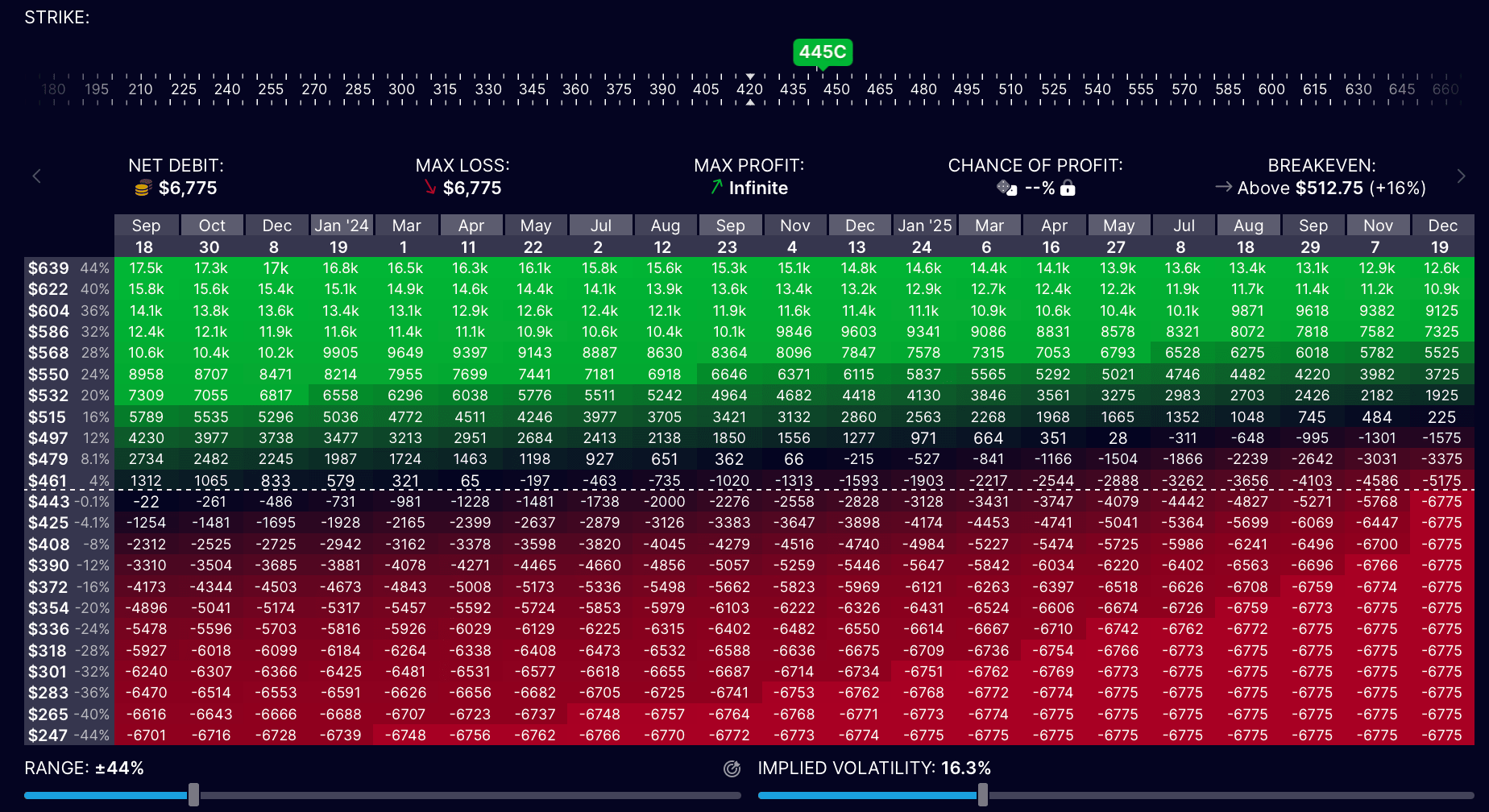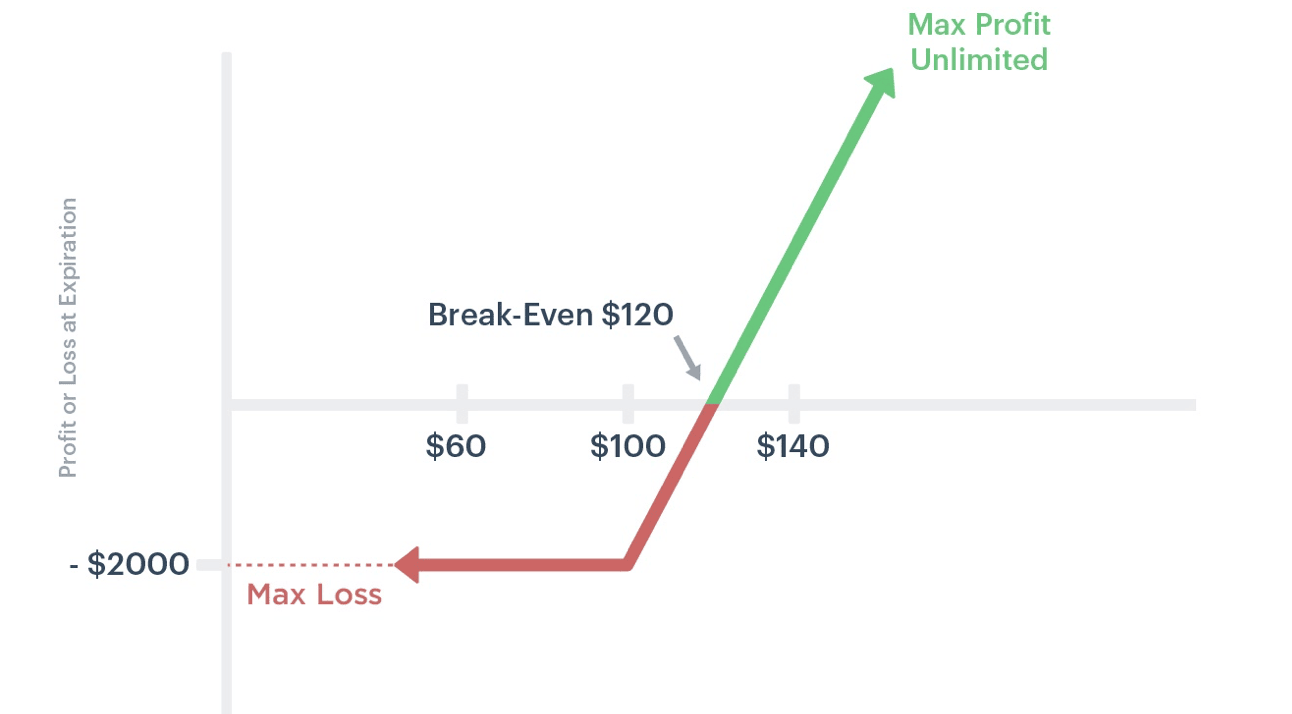What you'll learn:
➤ What are LEAPS?
Long-Term Equity Anticipation Securities, commonly known as LEAPS, are special publicly traded options contracts with an expiration period exceeding one year.
LEAPS essentially function like regular single-leg call or put options but come with significantly longer maturities.
While buyers have the right to exercise LEAPS options before they expire, sellers are obliged to fulfill the terms of the contract if assigned the options position.

In many respects, holding LEAPS is akin to maintaining a long-term stock position, but with well-defined risk and substantially less capital investment. While LEAPS strategies share similarities with short-term options strategies, they tend to favor buying strategies over selling strategies due to their slower rate of time decay.
| Key Takeaways: Mastering LEAPS Options |
|---|
| LEAPS Basics: LEAPS are options contracts with expirations exceeding one year, functioning like standard call or put options. |
| Buyer’s Right, Seller’s Obligation: LEAPS buyers have the right, but not the obligation, to exercise the option, while sellers are obligated to fulfill the contract’s terms if assigned. | |
| Initiating LEAPS: To start a LEAPS position, you can buy-to-open (BTO) or sell-to-open (STO) a contract, with the key difference being a minimum one-year expiration for LEAPS qualification. |
| Advantages of LEAPS: LEAPS offer long-term exposure to assets with reduced capital allocation and defined risk, making them a cost-effective alternative to long-term stock positions. | |
| Risk and Reward: Understand that while LEAPS provide lower capital risk, they come with higher premiums and extended break-even points due to their extended expiration. | |
| LEAPS Adjustment: Like other options contracts, LEAPS can be adjusted throughout their duration, allowing investors to manage risk or increase credit. | |
| Time Decay Impact: Time decay has a minimal effect on LEAPS for most of their lifespan, with theta becoming significant in the final 60 days before expiration. | |
| Implied Volatility Impact: LEAPS are sensitive to changes in implied volatility, with increased volatility benefiting long options contracts. | |
| Exiting LEAPS: Exiting LEAPS mirrors the process for short-term options contracts, either through selling or exercise, depending on the option type. | |
| Hedging with LEAPS: The extended timeframe of LEAPS contracts makes them valuable tools for hedging long-term positions or managing risk. | |
➤ How do LEAPS work?
LEAPS behave much like short-term options, but they operate within a significantly extended time frame. Investors use LEAPS in a variety of ways, including generating income, speculating on future price movements, and hedging against potential risk in other options or stock positions.
LEAPS can also be incorporated into multi-leg strategies by combining them with other option contracts. One of the primary advantages of utilizing LEAPS options is the reduced capital requirement when compared to owning or shorting stock over the same extended period.
Moreover, the downside risk is clearly defined at the point of entry and limited to the premium paid for the LEAPS contract.
For instance, if an investor seeks to hold 100 shares of a stock trading at $100 each, the initial capital needed for the trade would be $10,000. In this scenario, the entire $10,000 would be at risk if the underlying asset were to plummet to $0.
Conversely, achieving similar exposure through a LEAPS call option would entail only a fraction of the initial capital outlay.
Additionally, investors can sell LEAPS to collect credits. These options can be effectively used alongside short or long-term options contracts to create cost-efficient, risk-defined strategies. They can also be combined with stock positions to provide hedging capabilities.
LEAPS serve as substitutes for stock shares in strategies that combine stock ownership with short options contracts, such as covered call writing.
➤ How to set up LEAPS
LEAPS, or Long-Term Equity Anticipation Securities, are established just like other options contracts. To initiate a LEAPS position, you can either buy-to-open (BTO) or sell-to-open (STO) a contract from the options chain.
The key distinction is that the expiration date for LEAPS must extend at least one year into the future to qualify as such.
Due to their extended timeframes, LEAPS options inherently carry higher prices, primarily due to their significant extrinsic value.
The Greeks (Delta, Gamma, Vega, Theta, Rho) play a substantial role in LEAPS pricing. The extended timeline makes these options more sensitive to changes in implied volatility, interest rates, and underlying stock price fluctuations.
➤ LEAPS Payoff Diagram
The payoff diagram for purchasing a single-leg LEAPS contract resembles the profit and loss potential of a long call or long put option. The risk is limited to the initial debit paid at the point of entry, while the profit potential remains unlimited.
The cost to enter a long LEAPS contract is notably higher compared to shorter-term options due to the extended time until expiration.
Consequently, this impacts the break-even points, which are much further from the strike price. The basic principle remains the same: for profitability, the stock price must surpass the strike price plus the debit paid.
For instance, if a long call option with a $100 strike price is acquired for $20.00, the maximum loss is capped at -$2,000, and profit potential is limitless as long as the stock continues to rise. However, the underlying stock must surpass $120 to realize a profit.

If a LEAPS call or put contract is sold, the initial credit received represents the maximum potential profit for the trade. In such cases, considerably more credit is collected than with shorter-term options, and the break-even range becomes more extensive.
However, when selling naked options, be mindful that risk extends beyond the premium collected.
When multiple LEAPS are bought or sold to create multi-leg strategies, the payoff diagrams align with those of short-term strategies.
How to enter LEAPS
Initiating LEAPS follows the same procedure as entering short-term options contracts. Premiums and other relevant information can be found on the options chain. Options may be bought or sold or combined, just like with any other options contract.
The most significant distinction is the pricing relative to short-term options. LEAPS carry higher premiums, but this is a trade-off for having capital-effective, long-term exposure to stocks.
How to exit LEAPS
Exiting LEAPS is no different from exiting short-term options contracts. For options with American-style expiration, the position can be closed at any time before expiration by reversing the initial entry order.
For instance, if a long call was bought to initiate the position, it can be sold to exit. A profit will be realized if it’s sold for more than the purchase price. If the option follows a European-style expiration, exiting the position or early exercise is not an option. The option will be cash-settled on the expiration date.
➤ Time decay & implied volatility
Time decay minimally influences a LEAPS contract’s extrinsic value during the majority of its lifespan. Theta, or time decay, accelerates significantly as an option nears its expiration date.
Typically, the effects of time decay are not substantial until the last 60 days before expiration. Given that LEAPS have at least one year of time value, theta significantly contributes to the contract’s extrinsic value.
The longer time until expiration an option has, the more opportunities the underlying asset has for price movement, resulting in a higher option price.
Implied volatility can substantially affect LEAPS. If implied volatility increases significantly before expiration, it benefits the long options contract.
Conversely, a decrease in implied volatility can negatively impact an option’s premium. If volatility contracts before expiration, the price of the long contract decreases.
Implied volatility, or vega, is impossible to predict and is relative, meaning what seems low currently may not be so in the future.
How to adjust LEAPS
LEAPS can be adjusted just like any other options contract. Throughout the contract’s duration, additional positions may be added to manage risk, increase credit, or hedge against adverse price movement.
Given the extended maturity of LEAPS contracts, investors often choose to wait to make adjustments.
How to roll LEAPS
LEAPS can be rolled if the option nears expiration and remains unprofitable. However, the original pricing significantly influences whether the contract is adjusted for a credit or a debit.
If the underlying stock price has moved significantly away from the profit target, or if implied volatility has experienced substantial changes, rolling the position in a cost-effective manner may be challenging.
Many factors contribute to the decision of rolling LEAPS as expiration approaches, but the mechanics are akin to adjusting any options strategy.
Due to LEAPS’ long-dated maturity, short-term contracts are frequently sold against long LEAPS positions. These short-term contracts can then be rolled from one expiration period to another to generate income, as is the case with a synthetic covered call strategy.
How to hedge LEAPS
Due to the extended timeframe of LEAPS contracts, hedging the position or using the option to hedge other positions is advantageous for investors. LEAPS are often employed to hedge existing long-term positions.
For example, if an investor intends to hold a stock for many years, they may purchase a long-dated put option to hedge against future risk. Stock positions and options strategies can also be used to hedge LEAPS.
The lengthy maturity of LEAPS contracts provides investors with considerable flexibility in creating risk-defined hedges or seeking potential for greater profit.
➤ LEAPS Options FAQ
Definition of LEAPS options:
LEAPS, or Long-Term Equity Anticipation Securities, are options contracts with an expiration date longer than one year. They function similarly to single-leg call or put options but come with extended maturities.
Buyers have the right, but not the obligation, to exercise the option before it expires, while sellers are obligated to the contract’s terms if assigned the options position.
Example of a LEAPS option:
A LEAPS option is an options contract with a duration exceeding one year until expiration. Initiating a LEAPS position is much like starting any other options contract.
Investors can either buy-to-open (BTO) or sell-to-open (STO) a position by selecting a contract from the options chain. The primary distinction is that the expiration date must be at least one year into the future to qualify as a LEAPS contract.
Advantages of LEAPS:
LEAPS offer investors long-term exposure to an asset with significantly lower capital allocation and defined risk.
For instance, if you want to hold 100 shares of a stock trading at $100 each, the initial capital required would be $10,000, and all of it would be at risk if the underlying asset dropped to $0.
However, achieving a similar exposure through a LEAPS call option would require only a fraction of the capital outlay, providing a more cost-effective approach to long-term investing.
⬇️ More from thoughts.money ⬇️



